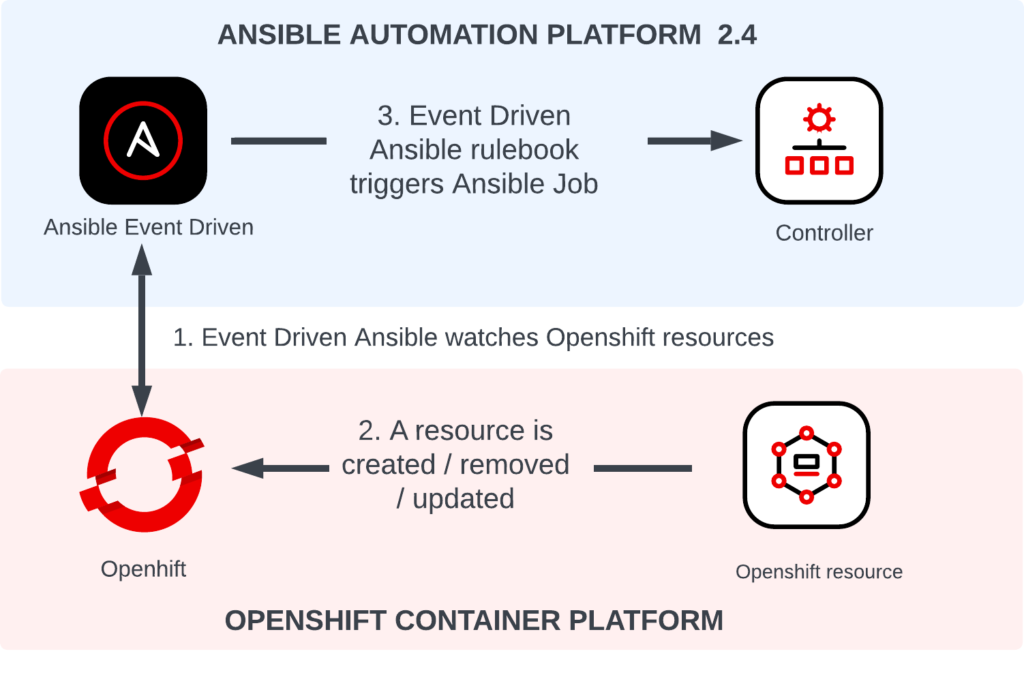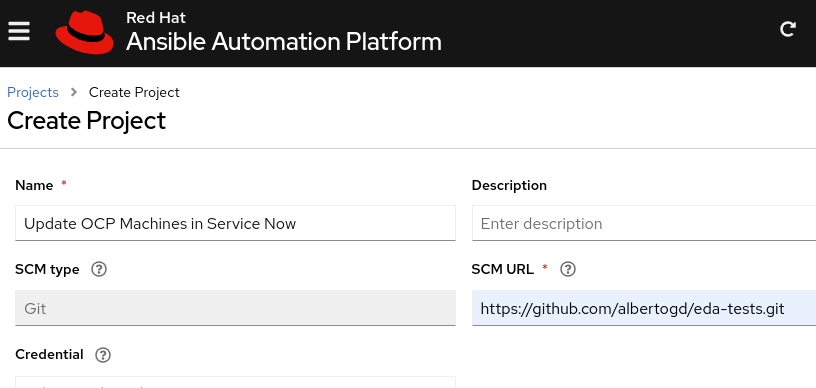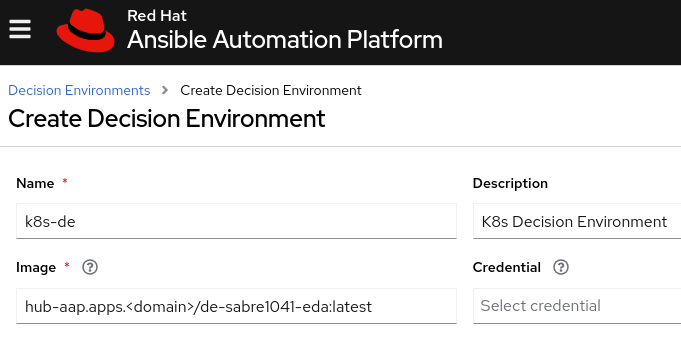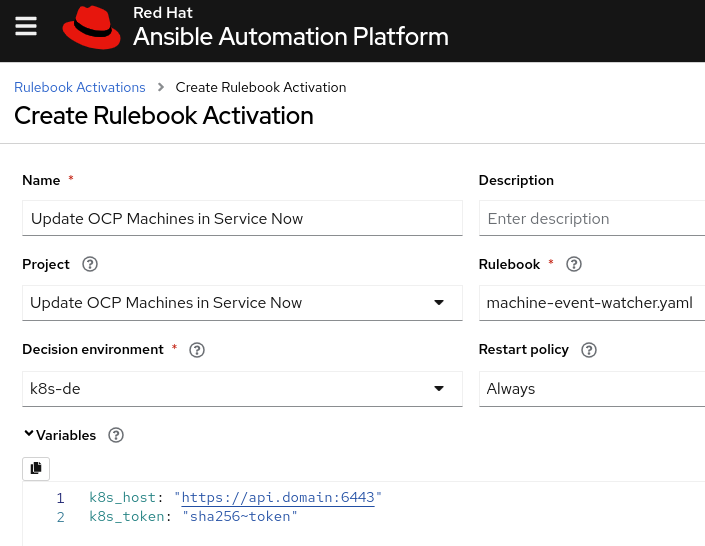Running Ansible Jobs in AAP 2.4+ with EDA watching OpenShift events
In the article Kubernetes Meets Event-Driven Ansible (EDA), Andrew Block explained how Automation and Kubernetes go hand in hand and how Ansible already plays a role within this ecosystem. When the article was written, EDA was not included in Ansible Automation Platform (AAP) yet, and the rulebooks had to be executed in the CLI or packaged within custom solutions. With the release of AAP 2.4, EDA is now part of AAP, and the Ansible Rulebooks can be executed in AAP.
In this article, I will describe the use case of running Ansible Jobs in AAP 2.4 with EDA watching OpenShift events: Register/unregister OpenShift machines in Service Now watching machine-api events

Register/unregister OpenShift machines in Service Now watching machine-api events
In OpenShift, a MachineSet creates and removes Machines (Nodes) just by changing the `replicas` parameter. However, triggering post-event actions is not easy. Some companies need to register/unregister the machine in their CMDB. Others need to add/remove the machine IP in their corporate DNS (Bind, Infoblox, etc.).
With EDA, we’ll be able to register/unregister Openshift machines in Service Now watching events.
Prerequisites
As a first step, we need Ansible Automation Platform 2.4 with EDA deployed:
- Deploying Event-Driven Ansible controller with Ansible Automation Platform Operator on OCP
- Installing Event-Driven Ansible controller on Red Hat Ansible Automation Platform
Solution
In EDA, there will be an Ansible Rulebook to watch for Machine API events. When the rulebook detects a Machine creation/deletion event, it will trigger an Ansible Job Template in AAP to register/unregister the machine in CMDB (ServiceNow).

For this solution, you’ll need:
- An Ansible Rulebook to watch for the events, and trigger an Ansible Job Template when we detect a Machine create/delete event.
- The Ansible Rulebook in a Git repository.
- In the EDA UI, the Ansible Rulebook added to a Project.
- The Decision Execution (DE) Image that includes the Ansible and Python dependencies
- A container image that is created and uploaded to our container registry or Automation Hub.
- In the EDA UI, the DE is added as a Decision Environment.
- An Ansible Job Template to register/unregister a Machine in ServiceNow.
- The playbook in a git repository.
- In automation controller, a Project and a Job Template
- An activation rulebook to run an Ansible Rulebook to watch for a specific Openshift cluster
- In EDA UI, an activation rulebook will be created
Ansible Job in Ansible Automation Platform
The Ansible Rulebook will run the Ansible Job Template Update machine in SNOW, so we need to create this Job Template in Ansible Automation Platform.
Project
First, create a playbook to update a machine in ServiceNow. Create the playbook snow.yaml, and commit and push the addition to your git repo.
---
- name: Update a machine in SNOW
hosts: localhost
gather_facts: false
tasks:
- name: Register the newly-created host instance
servicenow.itsm.configuration_item:
name: "{{ machine }}"
sys_class_name: cmdb_ci_vm_instance
when: action == 'add'
- name: Deregister the removed host instance
servicenow.itsm.configuration_item:
name: "{{ machine }}"
state: absent
when: action == 'delete'Create a Project in Ansible Automation Platform with your git repo, and then create a Job Template using this Project, and add a Survey with the 2 variables defined in the ansible-rulebook: machine and action.
After you add the Survey variables, don’t forget to click on Survey Enabled
Ansible Rulebook
As the Ansible documentation details We need a rulebook to tell the system what events to flag and how to respond to them. In the ansible-rulebook, there are 2 main sections: sources and rules.
Sources
The sources are the plugins to read events. They are written in Python and include a number of out of the box options that are included with EDA. The source plugin used to watch Kubernetes events is named _sabre1041.eda.k8s_. For this situation, OpenShift _Event_ or _Machine_ objects provide information about Machines that are created or deleted. In this case, we’ll use Event objects, but we can achieve the same results watching Machine objects.
The `sabre1041.eda.k8s` source:
- Watches for _Event_ objects in the `openshift-machine-api` namespace.
- Specifies the OpenShift API server (`host` var) configured with the variable `k8s_host`
- Specifies the ServiceAccount token (`api_key` var) configured with the variable `k8s_token`
Both vars, k8s_host and k8s_token, are configured later in the Rulebook activation in EDA UI.
The OpenShift ServiceAccount is any ServiceAccount that is available in OpenShift for this purpose. A role needs to be added to the targeted ServiceAccount to be able to perform the watch/list/get actions in the openshift-machine-api namespace. An example of the ClusterRole and RoleBinding needed.
ClusterRole:
apiVersion: rbac.authorization.k8s.io/v1
kind: ClusterRole
metadata:
name: events-reader
rules:
- apiGroups: ""
resources:
- events
verbs:
- list
- watch
- getRoleBinding:
apiVersion: rbac.authorization.k8s.io/v1
kind: RoleBinding
metadata:
name: events-reader
namespace: openshift-machine-api
roleRef:
apiGroup: rbac.authorization.k8s.io
kind: ClusterRole
name: events-reader
subjects:
- kind: ServiceAccount
name: default
namespace: aapRules
We’ll add one rule for detecting deleted Machines and another rule for detecting added machines. For each rule, we’ll run the job template `Update machine in SNOW` if the condition for the rule is met. The conditions are:
event.resource.reason== “Deleted” for machines deletedevent.resource.reason== “Updated” for Added machines
We’ll add the condition event.resource.count to avoid running the same job multiple times, as machine-api creates multiple events when a machine is deleted or added.
You can remove the
event.resource.countcondition, as yourUpdate machine in SNOWplaybooks should be idempotent, and could be executed multiple times with the same parameter.
We’ll define 2 extra_vars to send to the Job: machine which contains the hostname, and action which is add or delete.
The whole rulebook machine-event-watcher.yaml:
- name: Listen for Machine resource events
hosts: all
sources:
- sabre1041.eda.k8s:
api_version: v1
kind: Event
namespace: openshift-machine-api
host: "{{ k8s_host }}"
api_key: "{{ k8s_token }}"
rules:
- name: Notify Deleted machines
condition: event.resource.reason == "Deleted" and event.resource.count == 1
action:
run_job_template:
name: "Update machine in SNOW"
organization: "Default"
job_args:
extra_vars:
machine: "{{ event.resource.involvedObject.name }}"
action: "delete"
- name: Notify Added machines
condition: event.resource.reason == "Updated" and event.resource.count == 1
action:
run_job_template:
name: "Update machine in SNOW"
organization: "Default"
job_args:
extra_vars:
machine: "{{ event.resource.involvedObject.name }}"
action: "add"We’ll add this rulebook in a git repository, and in EDA UI, we’ll create a Project:

Decision Environment
As playbooks in AAP are executed using an Execution Environment (EE) image , Ansible-rulebooks are executed using a Decision Environment (DE) image . As we need to include our event source plugin in the DE as it is not provided in the base DE by default we create the configuration yaml for ansible-builder to create a new DE much in the same way as we do to create an EE. The base image used is de-minimal-rhel8:latest, and we need to add:
- The collections ansible.eda and sabre1041.eda (which provides the event source plugin for k8s)
- The python libraries requests and kubernetes, which are required by the event source plugin
- The system packages: pkgconf-pkg-config, systemd-devel, gcc and python39-devel
This is the Decision Environment Definition file: de-sabre1041-eda.yml
version: 3
images:
base_image:
name: 'registry.redhat.io/ansible-automation-platform-24/de-minimal-rhel8:latest'
dependencies:
galaxy:
collections:
- ansible.eda
- sabre1041.eda
python:
- requests
- kubernetes
system:
- pkgconf-pkg-config [platform:rpm]
- systemd-devel [platform:rpm]
- gcc [platform:rpm]
- python39-devel [platform:rpm]
python_interpreter:
package_system: "python39"
options:
package_manager_path: /usr/bin/microdnfBuild the Decision Environment image and push to the Automation Hub (or any other registry):
$ ansible-builder build -f de-sabre1041-eda.yml -t de-sabre1041-eda:latest
$ podman tag localhost/de-sabre1041-eda:latest <automationhub>/de-sabre1041-eda:latest
$ podman push <automationhub>/de-sabre1041-eda:latestIn EDA UI, add the custom Decision Environment:

Rulebook Activation
To create a rulebook activation, you need to have a controller token added. If you have not added one yet, please follow the documentation to add it.
Create the Rulebook Activation in the EDA UI. Select the Project, the rulebook and the Decision Environment, And configure the OpenShift variables: k8s_host with the API server, and k8s_token with a ServiceAccount token.

Testing the Solution
Add or remove a machine within your OpenShift environment. Openhsift machine-api will create multiple events in openshift-machine-api namespace. As the rulebook is monitoring for Event changes in the openshift-machine-api namespace, when the condition is met, it will trigger the job Update machine in SNOW. Check in your AAP that the Job has been triggered.

Summary
We’ve created an Ansible Rulebook to watch for Openshift Machine events, and trigger an Ansible Job to add or remove the machine in ServiceNow. This concept can be applied to many purposes in Openshift, like day-2 configuration when an Openshift resource is modified; notification or remediation when an Event contains a specific error message.